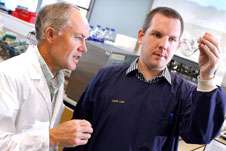Researchers discover how soils control atmospheric hydrogen

(Phys.org) —University of Otago researchers are helping to clear up an enduring mystery regarding the composition of the Earth's atmosphere. They have discovered the microbial soil processes that help ensure that the explosive gas hydrogen remains at trace levels.
In recent decades it was found that around four-fifths of all hydrogen released into the air is rapidly removed through soil activity, but exactly what is recycling it, and how, has remained unclear.
Now, Otago scientists have shown that the soil bacterium Mycobacterium smegmatis uses two special enzymes that can efficiently scavenge hydrogen as fuel at very low concentrations. They also found the bacterium ramps up these enzymes' activity when starved of its usual carbon-based energy sources.
The Department of Microbiology & Immunology researchers' findings appear in the prestigious journal Proceedings of the National Academy of Sciences (PNAS). Their discovery has implications for improved understanding of global climate processes and for developing new catalysts for hydrogen fuel cells.
Study lead author and Otago PhD candidate Chris Greening says the findings emerge from a project led by Professor Greg Cook investigating why the mycobacteria family, which includes members causing TB and leprosy, have genes encoding hydrogenase enzymes. Hydrogenases are well-known for their roles in anaerobic bacteria, but this is the first comprehensive study of these enzymes in an organism that requires oxygen to combust their fuel sources.
"Hydrogen scavenging is just one example of the ingenuity of microorganisms. Bacterial metabolism is much more flexible than that of humans. While we rely on carbon sources such as sugars and amino acids, many bacteria can use gases (e.g. hydrogen, carbon monoxide) and even metals (e.g. iron, uranium) as fuel sources for growth and survival," says Mr Greening.
It now appears that M. smegmatis and several other species of soil actinobacteria are demonstrating a metabolic flexibility that would provide a powerful advantage over other aerobic microbes in soil ecosystems, he says.
"High-affinity hydrogenases allow these bacteria to harness hydrogen to survive on when their standard carbon-based fuel sources are absent. While hydrogen is at low concentrations in the air, it is essentially a constant and unlimited resource. This means that bacteria scavenging this highly dependable fuel source would be especially competitive against other organisms in their volatile environments."
On a global scale, this activity leads to soil actinobacteria serving as the main sink for atmospheric hydrogen. This in turn influences the concentrations of other gases in the atmosphere, including potent greenhouse gases such as methane and nitrous oxide, he says.
Mr Greening says that hydrogenases have additionally attracted interest from researchers working to make dependable, inexpensive hydrogen fuel cells a reality. "Developing a catalyst that mimics the high-affinity, oxygen-tolerant action of the hydrogenases in M. smegmatis would provide an enormous boost for this technology," he says.
More information: Chris Greening, Michael Berney, Kiel Hards, Gregory M. Cook, and Ralf Conrad. "A soil actinobacterium scavenges atmospheric H2 using two membrane-associated, oxygen-dependent [NiFe] hydrogenases." PNAS 2014 ; published ahead of print March 3, 2014, DOI: 10.1073/pnas.1320586111
Journal information: Proceedings of the National Academy of Sciences
Provided by University of Otago


















